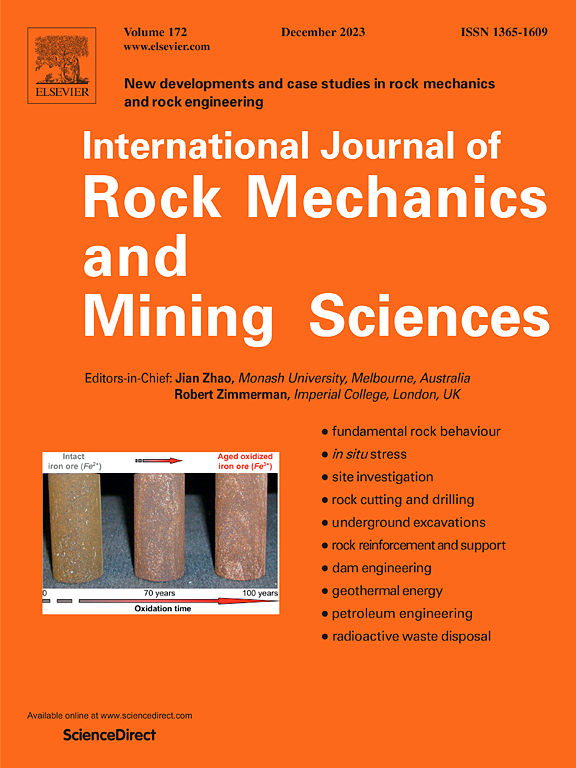Mechanical properties of shale during pyrolysis: Atomic force microscopy and nano-indentation study
IF 7
1区 工程技术
Q1 ENGINEERING, GEOLOGICAL
International Journal of Rock Mechanics and Mining Sciences
Pub Date : 2024-10-17
DOI:10.1016/j.ijrmms.2024.105929
引用次数: 0
Abstract
Quantitative characterization of the geo-mechanical properties of shale and organic matter (OM) holds paramount significance in the assessment of shale gas reserves and the design of hydraulic fracturing. However, the mechanical evolution processes during shale hydrocarbon generation and its influencing factors have received limited attention. This study examines the changes in shale mechanical properties during pyrolysis at high temperatures (415–600 °C) and high pressure (50–125 MPa) for mature to over-mature stages. The nanoindentation and in-situ AFM-QNM analysis are utilized to characterize the changes in mechanical properties during evolution. Subsequently, gas adsorption, Fourier Transform infrared spectroscopy (FTIR), and laser Raman spectroscopy (Raman) are used to investigate the factors influencing the mechanical properties of shale and the associated OM, and establish a model for the evolution of the mechanical properties. The results demonstrate that with increasing maturity, the overall Young's modulus of the bulk shale gradually increases from 42.8 GPa to 58.4 GPa for the temperature increment from 415 °C to 600 °C. During the thermal maturation process, the mesopore structure and quartz content of the shale significantly influence its mechanical properties. Young's modulus of OM shows an S-shaped trend, with variations in the micromechanical properties of OM corresponding to stages of hydrocarbon generation. In particular, two peaks of Young's modulus increase are observed during the mature and over-mature stages. In the mature stage, the aromatization of the kerogen leads to substantial detachment of aliphatic side chains and oxygenated functional groups, resulting in a higher degree of aromatization. This reduces the kerogen spacing and consequently increases the Young's modulus. In the over-matured stage, the process of aromatics condensation leads to the orientation and arrangement of aromatic rings, reducing the number of key site vacancies and crystal defects, thereby forming large aromatic clusters and significantly increasing the graphite-like structure. This study will facilitate the analysis of shale matrix deformation mechanisms at the microscale, providing a fundamental theoretical and scientific basis for shale fracturing design, exploration, and development.
热解过程中页岩的机械特性:原子力显微镜和纳米压痕研究
页岩和有机物(OM)地质力学特性的定量表征对于评估页岩气储量和水力压裂设计具有重要意义。然而,页岩碳氢化合物生成过程中的力学演变过程及其影响因素受到的关注有限。本研究探讨了页岩在高温(415-600 °C)高压(50-125 兆帕)热解过程中,从成熟到过成熟阶段的力学性能变化。利用纳米压痕和原位原子力显微镜-QNM 分析来表征演变过程中力学性能的变化。随后,利用气体吸附、傅立叶变换红外光谱(FTIR)和激光拉曼光谱(Raman)研究了影响页岩力学性能和相关 OM 的因素,并建立了力学性能演变模型。结果表明,随着成熟度的增加,温度从 415 °C 增加到 600 °C 时,块状页岩的整体杨氏模量从 42.8 GPa 逐渐增加到 58.4 GPa。在热成熟过程中,页岩的中孔结构和石英含量对其力学性能有很大影响。OM 的杨氏模量呈现出 S 型趋势,OM 的微观力学性能变化与碳氢化合物的生成阶段相对应。特别是,在成熟阶段和过度成熟阶段观察到两个杨氏模量增加的峰值。在成熟阶段,角质层的芳香化导致脂肪族侧链和含氧官能团大量脱落,导致芳香化程度更高。这就减少了角质层间距,从而增加了杨氏模量。在过成熟阶段,芳香族缩合过程会导致芳香环的取向和排列,减少关键位点空位和晶体缺陷的数量,从而形成大型芳香族簇,显著增加类石墨结构。这项研究将有助于在微观尺度上分析页岩基质变形机理,为页岩压裂设计、勘探和开发提供基础理论和科学依据。
本文章由计算机程序翻译,如有差异,请以英文原文为准。
求助全文
约1分钟内获得全文
求助全文
来源期刊
CiteScore
14.00
自引率
5.60%
发文量
196
审稿时长
18 weeks
期刊介绍:
The International Journal of Rock Mechanics and Mining Sciences focuses on original research, new developments, site measurements, and case studies within the fields of rock mechanics and rock engineering. Serving as an international platform, it showcases high-quality papers addressing rock mechanics and the application of its principles and techniques in mining and civil engineering projects situated on or within rock masses. These projects encompass a wide range, including slopes, open-pit mines, quarries, shafts, tunnels, caverns, underground mines, metro systems, dams, hydro-electric stations, geothermal energy, petroleum engineering, and radioactive waste disposal. The journal welcomes submissions on various topics, with particular interest in theoretical advancements, analytical and numerical methods, rock testing, site investigation, and case studies.

 求助内容:
求助内容: 应助结果提醒方式:
应助结果提醒方式:


